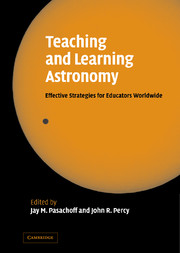Book contents
- Frontmatter
- Contents
- List of illustrations
- Preface
- Introduction
- Part I Astronomy in the curriculum around the world
- Part II Astronomy education research
- Part III Educating students
- Part IV Educating teachers
- Part V Astronomy and pseudoscience
- Introduction
- 12 Astronomy, pseudoscience and rational thinking
- 13 Astronomical pseudosciences in North America
- Part VI Astronomy and culture
- Part VII Astronomy in developing countries
- Part VIII Public outreach in astronomy
- Part IX The education programs of the International Astronomical Union
- Part X Conclusions
- Author index
- Subject index
Introduction
Published online by Cambridge University Press: 18 May 2010
- Frontmatter
- Contents
- List of illustrations
- Preface
- Introduction
- Part I Astronomy in the curriculum around the world
- Part II Astronomy education research
- Part III Educating students
- Part IV Educating teachers
- Part V Astronomy and pseudoscience
- Introduction
- 12 Astronomy, pseudoscience and rational thinking
- 13 Astronomical pseudosciences in North America
- Part VI Astronomy and culture
- Part VII Astronomy in developing countries
- Part VIII Public outreach in astronomy
- Part IX The education programs of the International Astronomical Union
- Part X Conclusions
- Author index
- Subject index
Summary
The prefix “pseudo” is derived from a Greek word meaning “false.” Pseudoscience refers to theories, assumptions, and methods that are mistakenly thought to be scientific. Obviously the distinction between science and pseudoscience is not clear-cut. Pseudoscience overlaps with scientific “misconceptions” - beliefs that are held by students and the general public that differ from scientific fact. Both of these concepts are subtle ones, since all scientific theories can be regarded as tentative to some degree.
At the 1996 IAU conference on astronomy education in London, UK, Neil Comins classified astronomical misconceptions into about 20 types, and he has described these in detail in his book Heavenly Errors (Columbia University Press, 2001). Some misconceptions are cognitive in nature; they are dealt with in our Part II. Others are products of religious belief or superstition (often transmitted through the “authority” of family or friends), or popular culture, or errors or excesses of the media. In relation to astronomy, notable pseudosciences include astrology, space aliens, and creationism; the works of Velikovsky also fall under the pseudoscience rubric. The majority of students will be affected in some way by these beliefs.
How to deal with them? The theory of constructivism is one of the most influential sciencelearning theories in schools today. It states that, by reflecting on their own knowledge and experiences, students build their own new knowledge about the universe around them. Teachers must therefore be aware of students' pseudoscientific beliefs, as well as their other misconceptions, if they are to correct them through their teaching. Many of them are deeply rooted. They cannot easily be changed by lectures and textbooks. They must be confronted through minds-on teaching.
Information
- Type
- Chapter
- Information
- Teaching and Learning AstronomyEffective Strategies for Educators Worldwide, pp. 163Publisher: Cambridge University PressPrint publication year: 2005
